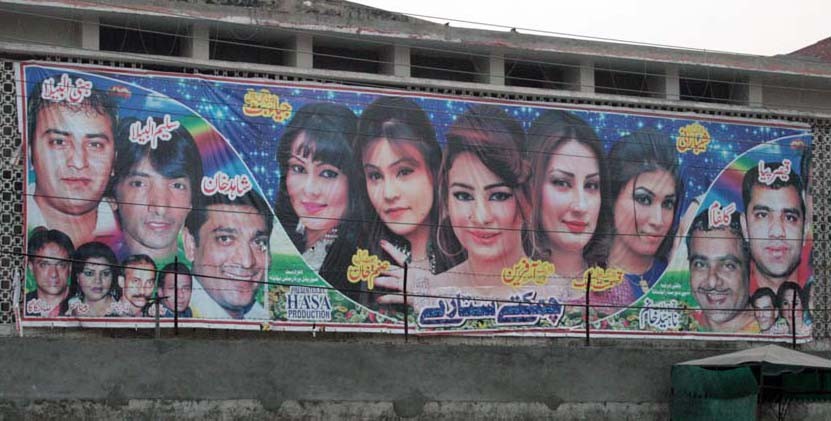
The more the laughs, the more people in the theatre and the more tickets sold. That sums up Punjabi commercial theatre

The Punjabi commercial theatre is a phenomenon that is much misunderstood and often maligned. The Punjabi theatre (the term commercial being superfluous as all professional theatre is, at the end of the day, commercial) evolved into its current form from the drawing room comedies performed at the Lahore Arts Council in the 1970s.
The decade of the 70s was a decade of cultural flowering in Pakistan and saw huge growth in the arts. The Pakistani cinema saw its peak with a record number of films being released and the theatre saw a number of new entrants who wished to use the medium to express themselves and air their views.
The new entrants in contrast to the earlier English medium western-influenced elite were often from the middle classes and brought with them their values and sensibilities. The dominant form at the time was the drawing room farce and this form, the new theatre writers and directors adapted to their world view.
The farce as it prevailed at the time and continues in contemporary theatre around the world is a play not dissimilar to what we are used to seeing as sitcoms on Television. Set in one location often the living room of a couple, newly wed or otherwise, the action involves a series of hilarious situations developing from an initial misunderstanding. These situations become more and more complicated and are finally resolved to create a happy ending. The singular purpose of the play being to entertain and delight its audience.
Kamal Ahmed Rizvi was perhaps the best writer of the farce in the 1970’s followed by M. Shareef and Jamil Bismil. Athar Shah Khan also tried his hand very successfully at this format. The genius of Kamal Ahmed Rizvi lay in his having read drama from England and Europe and then being able to construct plays inspired from those plots yet place them in the Pakistani middle class context which made them immensely popular with the theatre going public. Theatre also received a huge boost in attendance with the banning of alcohol in 1974 and the closure of bars with an increasing number of people turning to the theatre for their nightly entertainment.
The major change in the style of the plays came about in the 1980s when all other theatre venues were closed down by the authorities and only the Lahore arts council remained. Artists critical of the martial law were not given dates to perform and a new class of producer emerged. These producers often assisted and abetted by the Arts council authorities saw the theatre solely as a source of profit. The more the laughs, the more people in the theatre and the more tickets sold. Two comedians emerged who could always get a laugh, Amanullah and Albela. These two men brought standup comedy or the bhand into the theatre.
Since the ultimate aim was profit and not art the laugh became all important and other actors started to ape these comedians. Soon the more serious actors and the character actors started to find themselves out of work. The importance of the writer decreased as the producer always deferred to the wishes of the star comedians and the scenes would be adjusted to give their comic routines centre stage. For many years no play was performed without one or the other of the two stars of the Punjabi theatre.
By the 90s the writers had almost disappeared from the theatre. They would provide a loose plot or structure at best and the comedians would then improvise the rest of the play. The exception to this trend was the mega play Janam Janam ki maili Chadar produced and directed by Afzal Ahmed and based on the story of Umrao Jaan Ada. A new theatre, Tamaseel, was constructed for this play which ran for over two years in Lahore and also saw a franchised version in Rawalpindi.
Sohail Ahmed was the other main force trying to stand against the rising tide of Juggat Baazi. He worked hard to create plays that were closer in spirit and form to the farces of the 70s. However he faced an uphill battle with the rest of the playing field full of people not interested in change and often quite unaware of the possibilities of other forms of theatre. Dance was introduced in the Punjabi theatre in the 90s when the comics started to run out of ideas and in the absence of new writers the plays became stale and hackneyed.
The introduction of dance which is more a version of the mujra designed to titillate saw the departure from the theatre of the family audience. Women and children were not interested in the bawdy sexist jokes or the mujra designed to entice the men. This led to a change in the timings in the plays which would now start after 10pm and end at 1am.
The current plays if they can be called such are little more than a series of comic interludes interspersed with dances not unlike the burlesque or even the pantomime. The Punjabi theatre suffers from a lack of writers and new ideas and is in desperate need for new intellectual and financial investment. The state’s response to the crisis of creativity in the theatre has been to ban and discourage theatrical activity rather than to create avenues of growth for the emergence of new writer and directors.
The Punjabi theatre continues to employ some of the best comics in the country and needs new ideas to grow. With a little effort the Punjabi theatre has the potential to grow as a comic musical theatre that can address and use as its content Punjabi folklore as well as the contemporary issues of the Punjab.